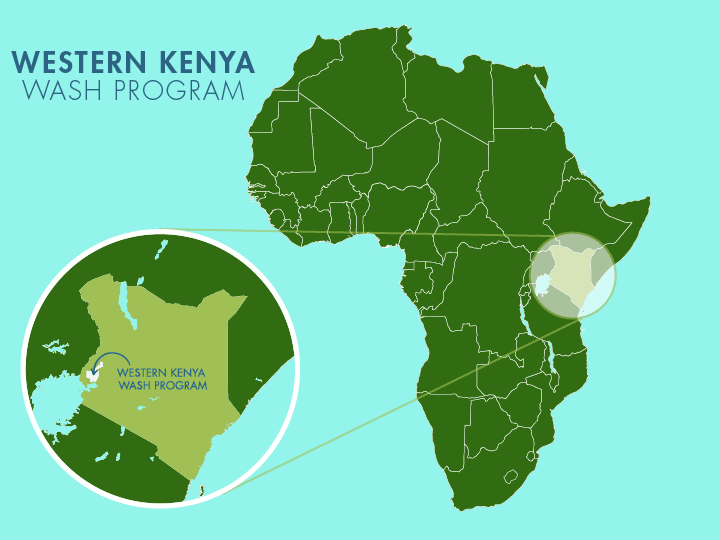In the Gemange Community, 70 community members and their families depend on a partially protected spring that has served them for many years. Although the spring was once a reliable source of water, it is now in a poor state; the concrete around it is cracked, and the stairwell and collection area have worn away. Still, the community does what it can to keep it clean and maintain its usability.

For Field Officer Mitchelle Ijaza, her time in Gemange revealed the depth of the community’s hardship, and it was a time she will not forget.
“The difficult situations children and women at large have to go through so that they can get water for their survival. Some people walk long distances to get water from this source. The travel distance consumes more time...This interferes with other plans the water users might have had in mind,” she reflected.
The people of Gemange once worked together to construct the spring that now stands in disrepair. “The water users contributed in material gathering for [the] construction of the spring that is currently in place but in poor condition,” Mitchelle says. “They helped each other to provide some of the materials while others helped in the construction process.”
However, today, cracks and reduced flow mean that queues form almost every day, and it’s the community’s children who feel the impact the most.
Only 12 years old, Claris spends a large part of her day fetching water.
“Sometimes, I get long queues and I am forced to wait for everyone who came before me to finish fetching so that I can fetch water,” Claris said. “Some people come with many jerrycans to fetch water without considering people who are behind in line."

Claris.
Most days, Claris spends about 90 minutes fetching water. Waiting in line is part of her routine, though it often cuts into the time she would rather spend learning or playing.
“I would read, do my assignments, play with my friends, and help my mother with some of the house chores,” she said when asked how she would use her time if she didn’t have to fetch water.

Jerrycans hold their place in line while community members wait to collect water.
Claris describes her community as respectful and orderly.
“We follow the queue accordingly, depending on the time someone went to fetch water,” she said proudly. But even with cooperation, the process takes a toll. “I feel frustrated at times, especially if it takes a lot of time away from doing my homework, playing, and resting.”
Though she insists that fetching water hasn’t yet affected her school performance, she dreams of the relief a repaired spring would bring.
“It does not [impact my schoolwork], but I'll feel relieved when our broken water source is repaired because it will be much easier to get water, and I will not have to worry about going all the way to a different water source," said Claris.

Claris hauls water home.
When we asked Claris about her dreams for the future, her answer was simple but full of quiet ambition. “I would like to develop a hobby, something I can be able to do for fun and be good at it.”
For Claris and her neighbors, each day begins and ends with the same challenge—fetching water from a broken spring. But soon, things may change. The proposed rehabilitation of their water point promises more than clean water. It promises safety, dignity, and time for children like Claris to study and play, as well as time for the whole community to grow together again.
Steps Toward a Solution
Our technical experts worked with the local community to identify the most effective solution to their water crisis. They decided to safeguard the existing flowing spring.
Spring Protection
Springs are natural water sources that originate from deep underground. As water travels through various layers of the earth, it undergoes a natural filtration process, making it cleaner and safer to drink. To protect these spring sources from contamination, we construct a waterproof cement structure around layers of clay, stone, and soil. This design channels the spring water through a discharge pipe, facilitating easier, faster, and cleaner water collection.
Chlorine Dispenser
As an extra measure towards water quality safety, uniquely engineered chlorine dispensers are installed at all of our spring protection projects so community members can treat their water with pre-measured doses of chlorine. The chlorine treats any possible contamination and stays active for two to three days, ensuring water stays safe to use even when stored at home. Chlorine delivery and maintenance of the dispensers are part of our ongoing community support.
Community Education & Ownership
Hygiene and sanitation training are integral to our water projects. Training is tailored to each community's specific needs and includes key topics such as proper water handling, improved hygiene practices, disease transmission prevention, and care of the new water point. Safe water and improved hygiene habits foster a healthier future for everyone in the community. Encouraged and supported by the guidance of our team, a water user committee representative of the community's diverse members assumes responsibility for maintaining the water point, often gathering fees to ensure its upkeep.

 Protected Spring
Protected Spring
 Rehabilitation Project
Rehabilitation Project
















